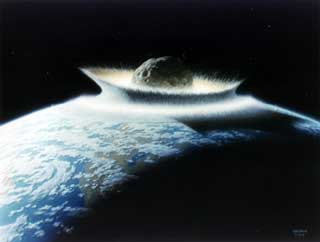A meteorite the size of a mountain hurtled from outer space and struck earth some 2020 million years ago, just south-west of where Johannesburg is today. The whole planet physically shook under the impact.
South Africans have called this area Vredefort and experts at the 29th annual World Heritage Committee meeting that is being held in Durban are expected to award it World Heritage Site status.
This is the oldest meteor site on the planet, but won't be the last, warns Wits University Professor of Mineralogy in the School of Geosciences, Prof Wolf Reimold.
"The impact of large extraterrestrial bodies with earth is an ever-present danger that humanity has only recently begun to recognise," said Reimold, who is the co-author of a new book called Meteorite Impact! The Danger from Space and South Africa's Mega-Impact: The Vredefort Structure.
The book explains how Vredefort is teaching a new generation of scientists around the world about the reality and danger of similar events in the future.
Three giants stand out
The book also reviews more than 200 000 years of human habitation in the area, starting with the early San hunters, whose art survives on the rocks formed during the meteor strike.
The successive settlements of Sotho-Tswana, Afrikaner and British farmers are also discussed, including landmark wars that affected the region over the last three centuries.
The book also provides a guide to more than 20 sites that highlight the heritage of this area.
Of the 175 impact craters found on the planet so far, three giants stand out - Chicxulub in Mexico, which wiped out 75% of life 65-million years ago, Sudbury in Canada, and Vredefort in South Africa. Each of these events catastrophically altered the global environment and was strong enough to drastically change life on our planet.
The Vredefort Impact Structure, with a 300km diameter, is nearly twice the size of the Chicxulub crater.
The outcroppings around the towns of Vredefort and Parys, known as the Vredefort Dome, show the scars of the cataclysmic forces that accompanied the impact event.
The rocks, ripped from the depths of the crust by the impact, also tell a far older story that stretches back to more than 3 500 million years ago, when the first continents formed on the primitive earth, and to the time when fabulous gold deposits accumulated on the margins of the ancient Witwatersrand sea.
There are already 788 world heritage sites in 134 countries in the world.
In South Africa, the sites are Robben Island in the Western Cape, the Cradle of Humankind that houses the fossil hominid sites of Sterkfontein, Swartkrans, Kromdraai and environs in Gauteng and North West, the Greater St Lucia Wetland Park in KwaZulu-Natal, the uKhahlamba Drakensberg Park in KwaZulu-Natal, the Mapungubwe Cultural Landscape in Limpopo and the Cape Floral Region of the Western Cape.
More . . .
Home


No comments :
Post a Comment
Dear Reader/Contributor,
Your input is greatly appreciated, and coveted; however, blatant mis-use of this site's bandwidth will not be tolerated (e.g., SPAM, non-related links, etc).
Additionally, healthy debate is invited; however, ad hominem and or vitriolic attacks will not be published, nor will "anonymous" criticisms. Please keep your arguments/comments to the issues and subject matter of this article and present them with civility and proper decorum. -FW